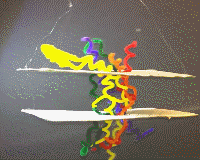Tutorial:The opioid receptor, a molecular switch
From Proteopedia
The opioid receptor, a protein on the surface of nerve cells, binds to opioids such as morphine, oxicodone, heroin, and fentanyl. Repeated intake of opioids changes the response to these molecules, and can lead to addiction.
Contents |
See also
This article explains, at a level appropriate to high school students or beginning college students, how the opioid receptor is switched on and off, and what happens inside the brain as a consequence. Other pages related to this topic are:
Relevance
When we want to turn on the lights in a dark room, we don't have to climb up a ladder to screw in a light bulb. All we have to do is flip a switch. A biological cell has switches, too, called receptors. Most are on the cell surface with a part sticking out, ready to bind to a signaling molecule. Another part of the receptor reaches into the inside of the cell, transmitting the signal. The opioid receptor can be switched on to relieve pain, for example during surgery. Tragically, it is very easy to become physically dependent on the signaling molecules. The ongoing opioid crisis in the USA shows how addictive opioids are (e.g. morphine, oxicodone, heroin, and fentanyl), with overdose deaths decreasing average life expectancy across the US population significantly.
Natural Function
The Mu Opioid Receptor is a protein construct found in the membrane of neurons. The human body has many opioid receptors; however these in particular react with morphine and other similar opioids involved in the 2010s Opioid Crisis. As of the late 2010s, the molecular shape of these mu opioid receptors has been discovered and documented.
These opioid receptors interact with opioids via a process known as Ligand Binding[1]. During this, an opioid molecule binds to the opioid receptor, resulting in what is known as conformational change[2]. This alters the shape of the receptor, causing it to release a GTP-binding protein (otherwise known as a G protein), which functions as the on/off switch of the cell's pain and dopamine receptors. When the G protein is released, it in turn binds to the pain receptor and the Dopamine receptor, causing the former to stop releasing pain signals, and the latter to release dopamine, which causes the body's pain to numb and the body to experience pleasure, respectively.
Once this has transpired, a new molecule gets released into the cell. This compound, known as Arrestin, creates more changes in the cell's internal environment. These changes first result in the opioid receptor being encapsulated in a membrane and dragged into the cell, which, due to increased acidity, ejects the bound opioid. Then, one of 2 events may occur with the opioid receptor itself. The first results in the receptor being returned to the cell's membrane for further use, and the second results in the receptor being broken down inside the cell to be later recycled entirely.
For further information, referenced is a 4:35 video providing visuals and a general overview of the above information. [3]
Disease and treatment
When it comes to opioid addiction, there are several steps involved with how it develops. The first step comes with the initial exposure. As exemplified in this fictional account , initial exposure can be through prescription medication. While some prescription medications include abuse-deterrent features, these have not prevent prescription drug abuse..
Once an individual takes an opioid medication, the aforementioned process transpires. When the arrestin begins to alter the cell's environment, it has with it a secondary effect. The process arrestin causes also develops drug tolerance[4], which makes the body more resistant to the pain-numbing and dopamine-releasing effects brought about by the presence of opioids in the body. Furthermore, the psychological impact of low pain and high dopamine result in the body desiring this effect from said opioids. Altogether, this sets the body up to take more and more opioids to get this feeling, and, in turn, building more and more tolerance. Attempting to go off of the drugs by this point results in withdrawal[5], which throws off the body's systems and the chemicals in the brain, altering personality and inflicting crippling side-effects.
When untreated, opioid overdose kills people because they stop breathing. The drug naloxone can prevent overdose deaths when administered in time.
The continual presence of opioids in the body can have with it other effects. Within pregnant mothers, it may result in what is known as Neonatal Abstinence Syndrome (NAS) , in which the fetus develops withdrawal symptoms after birth. This is due to the drugs passing through the placenta into the newborn's body prior to birth. Essentially, the infant becomes addicted before even being born, which, in turn, inflicts a myriad of health complications, some of which possibly fatal.
Structural highlights
| |||||||||||

